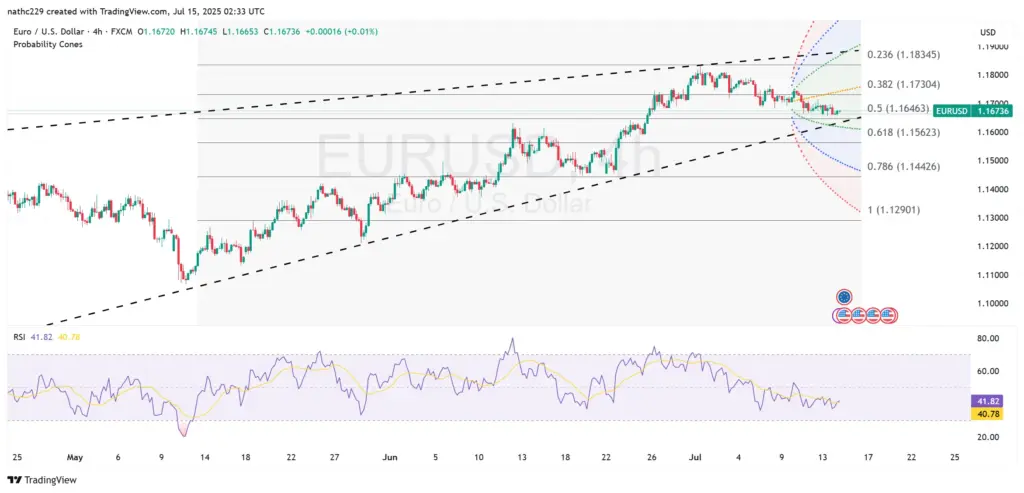EUR/USD Weakness Deepens as Technical Indicators and Trade Worries Dominate Sentiment

Overview
EUR/USD continues to drift lower, burdened by escalating U.S. tariff threats and robust technical signals that underscore significant bearish momentum. The euro's recent losses highlight growing market unease regarding Europe's economic outlook, particularly in the context of potentially severe trade disruptions. Traders are actively evaluating technical levels and upcoming economic indicators to assess further downside potential.
Technical Outlook
EUR/USD has exhibited pronounced bearish tendencies, commencing the New York session near the upper end of its overnight trading range between 1.1650 and 1.1697, but subsequently succumbing to considerable selling pressure. After a fleeting attempt to regain 1.1695, the pair encountered renewed downward pressure, sliding decisively below its crucial 21-day moving average toward the 1.1660 support zone.
Critical support levels now lie at the immediate low near 1.1660, with further psychological support at the pivotal 1.1600 level. Additional downside technical targets include the lower Bollinger Band at approximately 1.1550, and the essential support region near 1.1500, marking June lows.
Technical indicators remain strongly bearish, notably the formation of daily and monthly inverted hammer patterns coupled with falling RSI readings. These signals collectively highlight pronounced downward momentum, reinforcing the likelihood of continued bearish trends.
Resistance remains formidable, initially near recent highs at 1.1697, followed closely by the 21-day moving average around 1.1700. Further overhead barriers include the declining 10-day moving average at approximately 1.1725, effectively limiting upside recovery attempts.
Market Drivers and Economic Indicators
Fundamentally, EUR/USD weakness stems from heightened tariff concerns following President Trump’s threat of a 30% tariff on EU imports, potentially effective August 1. This development has significantly amplified bearish sentiment, as markets fear negative impacts on Eurozone trade flows, economic growth, and corporate earnings.
Concurrently, rising U.S. inflation expectations have strengthened the dollar, dampening prospects for immediate Federal Reserve easing. Persistent increases in U.S. 2-year and 5-year breakeven inflation rates underline market perceptions of elevated inflation, reinforcing a more hawkish Fed outlook and supporting ongoing dollar strength.
Critical upcoming U.S. data releases, including June’s CPI and PPI, remain pivotal for shaping market expectations regarding future Fed policy. Higher-than-anticipated inflation data would bolster dollar strength, exacerbating EUR/USD bearish pressures.
Additionally, potential ECB policy shifts in response to trade-related economic vulnerabilities could further pressure the euro. Increased likelihood of ECB easing measures to offset trade impacts and recent euro strength could accelerate downward momentum.
Risks and Consequences
Several key risks threaten EUR/USD, including potential tariff implementation and ongoing trade tensions, which pose substantial economic risks to the EU. Persistent U.S. inflationary pressures further complicate the outlook, potentially reinforcing dollar strength.
Technically, EUR/USD faces significant downside risks if it fails to sustain key supports around 1.1660 and 1.1600, opening deeper bearish potential towards 1.1500 and possibly the significant technical zone at 1.1350-1.1400.
Strategic Considerations
Bearish traders currently maintain strong market control, supported by robust technical indicators and negative fundamental drivers. Positioning stop-loss orders above the 21-day (1.1700) and 10-day (1.1725) moving averages can manage risk effectively.
Conversely, bullish traders should remain cautious, requiring clear bullish reversals above key resistances before initiating long positions. Positive EU data or easing trade tensions would be essential prerequisites.
Conclusion
EUR/USD’s bearish sentiment intensifies amid escalating tariff threats and robust technical signals. Traders should closely monitor forthcoming economic data, geopolitical developments, and key technical levels to strategically navigate this challenging market environment.
